by Texas Homesteader ~
You’ll remember a few weeks ago I was delighted to find a very beneficial tree at an old abandoned homestead sight on property we had recently obtained.
It was identified as a Jujube Tree. I picked much of the fruit from those trees and dehydrated Jujube fruit for use in my homemade Pumpkin Granola. They are absolutely delicious.
But recently RancherMan & I were checking on the cows in that remote pasture & I happened to look up and see what looked like the golden berries of a Soapberry Tree. I’d read about them before, but could it be??
Now I had researched this tree several years ago when I was using soapnuts in my washing machine as a more environmentally-friendly laundry option.
I loved the soapnuts, they were effective at cleaning our clothes and they kept me from buying commercial laundry detergent. (Along with all the packaging that generally comes along with it.)
In researching about soapnuts I read that there is a tree indigenous to the southwest called a Western Soapberry Tree. (or Sapindus saponaria ssp. drummondii ) I thought it would be so cool to run across one of these trees here on our homestead.
But alas, no such trees could be found.
Do I Spy A Western Soapberry Tree??
But on this day as RancherMan & I were standing at the pond of our remote pasture property talking to customers about animals they were about to purchase, I looked up and saw those golden orbs.
They looked just like the berries I had seen in my research years ago.
I’m sure our new customers must have thought I’d lost my mind! I excitedly secured some of those berries for further identification.
I took close-up pictures of the bark, the berries and even the seed inside the berries. Close-up photos were also taken of the alternate leaf pattern, both from the top & the underside.
I sent all the photos to my extension agent. She has been invaluable to me in identifying trees in the past.
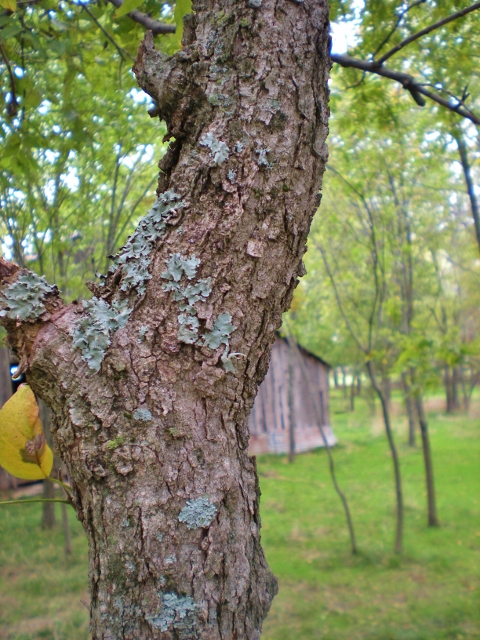
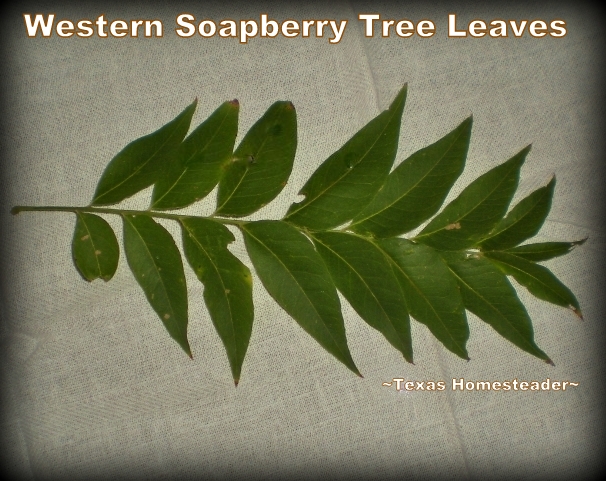
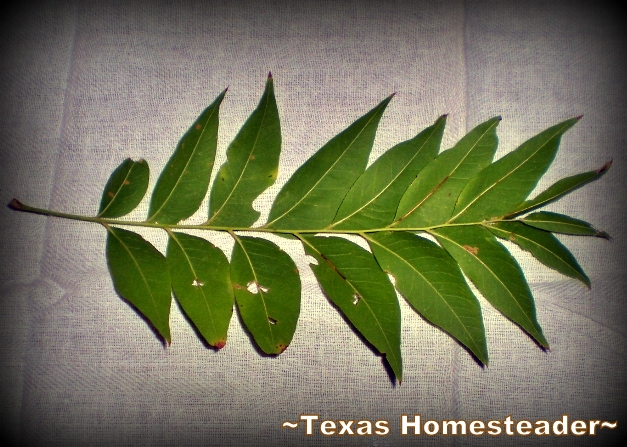
Photos To Extension Agent For Identification
I was excited when I received this response from my local extension agent:
“Several years ago we did some studies with one of the specialists on soapberry trees. So I have sent this to the Master Gardeners that were involved at that time. We all agree this is the soapberry tree.”
WOO HOO! It’s said that soapberries contain about 37% saponin & were used by native Americans and early settlers for cleaners and soaps.
So I’ve picked some of the berries and dried them. I used them in the small muslin bag that came with the soapnuts that I purchased awhile back.
I’ve read that it can cause skin irritations to those ‘susceptible to them’ so I tested it slowly at first. But I have used it for my own Home-Grown Laundry Detergent.
How very cool that a tree on our property could be providing our laundry cleaning!
I also use soapberries as a natural shampoo too. I’ll soak soapberries in water for 6 weeks, swirling the mixture from time to time.
Sometimes I infuse my soapy mixture with rosemary for an extra healthy-hair boost. Sometimes I infuse it with fresh mint.
When it’s completely infused I’ll strain the mixture, dilute it, add a small amount of baking soda and use it for a natural shampoo. A friend of mine does this and says it does a fantastic job cleaning her hair, and no conditioner is needed.
Gotta love this Western Soapberry Tree. It’s been so useful in lowering my environmental footprint. And you know that makes my crunchy green heart happy.
~TxH~
Want To Read More About Soapberries?
Want To See Our Natural Cleaning Posts?
- Homemade Powdered Laundry Detergent
- Why Complicate Cleaning?
- Grandma-Approved Cleaning Techniques
- Laundry-Scent Booster
- Cleaning Blood On Clothing
- Many Magical Uses For Baking Soda
- Make A Natural Air Freshener For Pennies
- How To Clean A Narrow-Neck Jar
- MYO Citrus-Scented Cleaner
- All-Natural Lavender-Scented Hand Scrub
- MYO All-Natural Carpet Cleaner
- Saving Your Fingernails While Cleaning
- Repurposing Mesh Bags For Scrubbing
- How To Use ALL Of Your Spray Cleaner
See All Our Natural Cleaning Posts

C’mon by & sit a spell! Come hang out at our Facebook Page. It’s like sitting in a front porch rocker with a glass of cold iced tea – lots of good folks sharing! You can also follow along on Pinterest, Twitter or Instagram.
If you’d like to receive an email each time a new blog post goes live it’s EASY to
Subscribe to our blog!

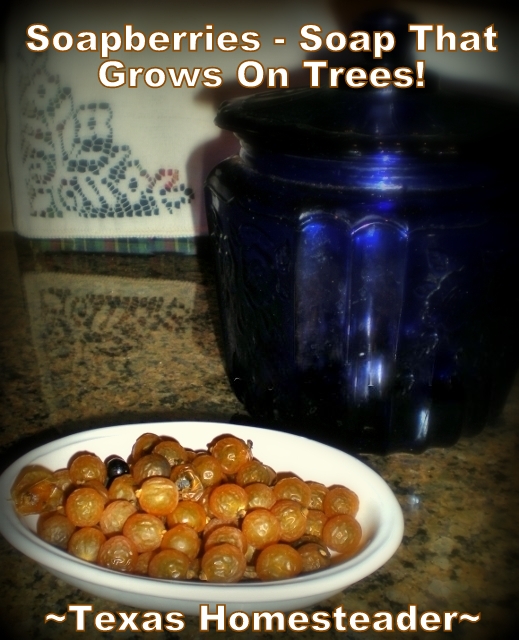
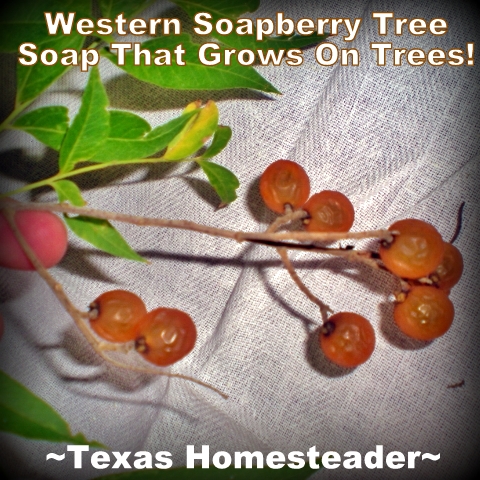
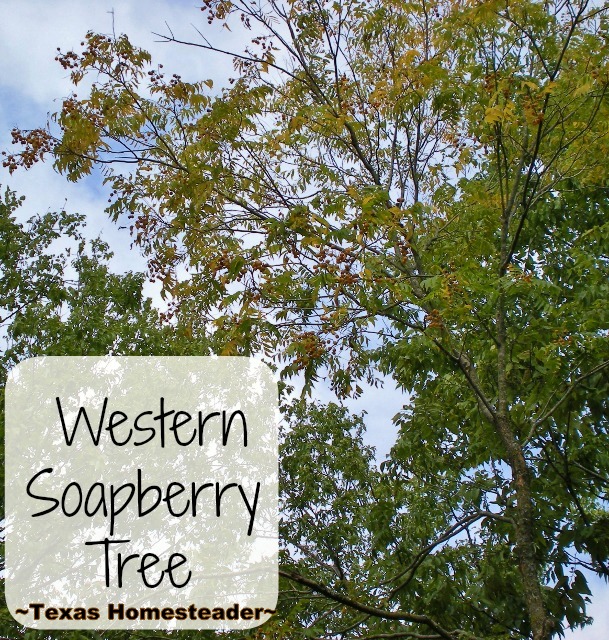
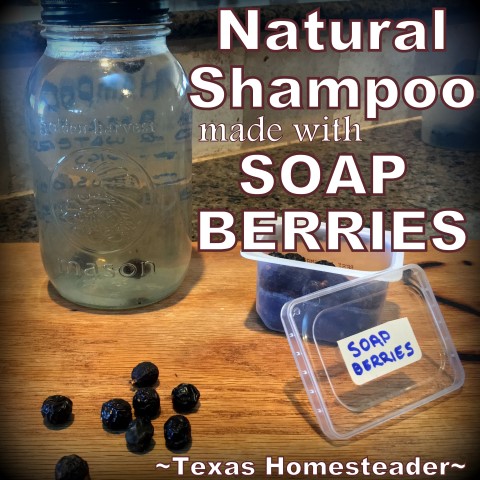

I think the whole “chinaberry” misnomer is more an old timers’ thing. My dad was born in 1920. His dad in 1882. Daddy always called them Chinaberries, I’ve had no luck with seeds, but read that they transplant well. Probably true since they sucker. I’ll actually be trying some in the next couple of weeks, I can send all the seeds a person might want.
From what I can tell, Soapberry & chinaberry are similar in many ways, but also different in other ways. The soapberry leaf has smooth edges, the Chinaberry leaves are more ruffled on the edges. They both grow berries that are yellow but I don’t believe Chinaberry berries contain any saponin. Chinaberries are slightly larger than soapberries. ~TxH~
Ther s a video on YouTube explaining the difference between a soap.berryband a China Berry and the guy doing the video cannot figure out how people confuse the two but they do.
This year, along highway 287 in North Texas, the Western soap Berry is making a spectacular bloom, revaling thousands of the trees int he cross timbers and rolling plains woods. There should be plenty of fruit this fall to make all the soap you’ll want. (2018)
I had no idea soap nuts grew in the States! I began using them in my hair shampoo bar several years ago (love the results!) and then began making a vinegar cleaner with ’em and LOVE the extra kick in cleaning power. The vinegar preserves the nature saponins for several months and the combination cuts through grime quicker. Perhaps you’d be interested to try?
So amazing you have a tree on your property! What a treasure!
I believe soap nuts are slightly different than soapberries autumn. Soapberries are smaller than soap nuts and they’re yellow softer-shelled berries. I believe the saponin levels are different as well. But you’re right, it’s a treasure to have a Western Soapberry Tree right there on our property. I’m planning to harvest more soon. ~TxH~
What a fantastic tree! there are no native soapberry trees growing in my area (Western Washington). I would love to trade some seeds or buy some of those berries from you! If that is possible. If you might be interested in a trade, I can send you my plant list.
In Alaska they are red berries that grow on shrubs… They are everywhere up here, which is great.
we always called those China berries when I was a kid growing up in Oklahoma. We never used them for laundry, never knew we could. But I made my grandma a necklace using the seeds. Not an easy task because the seeds were so hard. I’m gonna go back over to the old homestead and see if one of the trees still exist. If so I’m gonna collect some seed and try to get some going on our homestead. Thanks for the information. This is awesome.
I’m not certain Velvet, but I believe Chinaberry trees and Western Soapberry Trees are two different species. To be certain you can have your extension agent positively identify. I sent pics of the leaves, bark, description of the tree and pictures of the soap berries both in their clusters on the tree, separately and split in half. They identified my trees as the Western Soapberry tree. We had a Chinaberry tree in our back yard growing up and those were not the same as the trees I have on our property now. Good luck! ~TxH~
Hello,
I am so interested in your Soapberry Tree. The pictures look like what we call China Berry Tree. Is it the same? I live in Middle TN, but grew up in Southern Alabama and Central Florida and always loved to climb up and hide in the China Berry in our yard. The picture of the leaves and berries look the same and I am just curious to know if it actually is the same tree? Love your blog!!!!!
Thanks for your sweet words Dyan. We had Chinaberry trees in our yard growing up, the ones we had were almost ornamental size and umbrella shaped. The Western Soapberry tree is a different tree than the Chinaberry Tree, although both have small amber-colored berries. The Western Soapberry trees that we have are very tall & lanky – I’m not sure a Chinaberry’s berry actually contain any soponin, the natural soap substance present in Western Soapberry trees. ~TxH~
Be sure you can distinguish between chinaberry, which looks similar but is usually white and soapberry. Chinaberry berries and leaves are toxic.
We had Chinaberry trees in our back yard growing up, they were indeed beautiful. I can see how the Western Soapberry Tree & the Chinaberry tree have similar physical characteristics & Wikipedia warns that the leaves & berries of the Chinaberry Tree are toxic to humans if eaten, but I think it goes without saying you should never randomly eat berries or leaves of any tree or plant unless you know they’re safe for consumption. ~TxH~
Just found your blog! I’ve been using soapnuts for laundry for years and was wondering, if you don’t mind saying, what county in NE TX do you live? We moved to Red River County in NE TX from the city and bought an old homestead and although it is very hard, it is so rewarding! Anyway, I would love to know if Soapberry Trees are in my area – who knows, maybe I have one out in the pasture! Can’t wait to read more of your blog!
Loved the info about the soap berry tree I have two growing in my back yard, and I was wondering on how to use the berries. How do you dry them, and after dried I heard that you could let them simmer in water for 30 minutes, then use that mixture for laundry soap. Is that true, or is just using the whole dried berry in the washer better.
Soapberry trees in your back yard Tammy? (#jealous!) I simply allowed my soapberries to air dry until they were all wrinkled & felt hard (I guess about a month) I’m sure you can simmer the berries in water & use that strained soapy water the same as you would liquid laundry detergent, I’ll have to give that a try. I did laundry just the other day using the soap berries – about 6-7 tied in a small muslin bag. It did a great job cleaning our laundry. But I’d like to experiment with the liquid as well. ~TxH~
I have harvested the berries from our Western Soapberry trees but have not used them (this is my 1st harvest). Looking forward to your post. I have been wondering how to use them.
For the record, it never once occurred to me you’d lost your noodle. I was excited that you were excited. And if you ever need some advice from a tree novice, I have two awesome books in the camper. I refuse to use an “app” for that. Let me know how it all works out for you!! :o)
Ive always wondered about the soap nuts, my boys wear white shirts for school and I wondered whether they do really clean. How cool that you have one growing!
I’m intrigued..I’m fairly positive I’ve seen this tree around here or at least something very close. I’m going to inspect you photos a little closer and keep my eyes wide open when I’m walking about. Thanks for telling about your experience with the soapberry I had never heard of this. Congratulations on being featured on the Home Acre Hop.
Your discovery is super cool! I can just imagine how thrilled you were. I’d love to know how well they clean even though I live in the Southeast. Wonderful post! Have a great day.
What a terrific find! I have heard of soapnuts, but not a soapberry tree. Thanks for sharing with us at The HomeAcre Harvest Hop! I look forward to hearing how they work.
~Ann
How exciting for you! I’ve used soapnuts for a number of years and have always understood that they are extremely mild, which is why they are recommended for those who are bedridden and for babies, too.
I live in South Florida and I planted some soapnuts 4 years ago. You have to be very patient, they will sprout eventually. I now have a tree about 20 feet high. I am told I need to wait about 3 more years for soapnuts.
Its a pretty tree and looks good on my property
My dad once told us about helping his mom make soap using Soapberries. They lived just outside of Durant, Oklahoma where there used to be lots of Soapberry trees. I think they were considered a ‘trash tree’ and lots of them were cut down, because of the mess they leave when all the berries fall to the gound. You should try to grow some of the berries and start your own grove, you could call it Washer Woman Grove! Or Laundry Land.
How cool! I can’t wait to see how they work for you! 🙂
I’m excited to find out how this goes for you.
I was in the process of doing some of my own research here on our property…with a similar tree. Then, a storm came through and blew that tree down. Hmmmppphhh… ! I was not happy about that.
We have a small stand of trees that are very similar with leaves similar to these you’ve shown…but they are NOT mature trees yet. So we’ll have to wait to see if they produce these western soap berries. I’ve done a lot of the same research as you…so I’ll be watching for sure!
I had received some soap nuts from Live Ready Now …she traded me through the mail. I liked how well they worked. I was also looking forward to harvesting soap berries from out tree until it was blown down.
This would be wonderful to have such a resource! Hope these prove to be useful for you.
Pat (SW Kaufman County,TX)
How cool Pat that others have researched the very same thing as me! Yes, I’m very excited to give them a try, the berries are drying now & I’ll use them like I did the soapnuts earlier. These soap berries are smaller than the soapnuts I purchased so I’ll have to trial & error to figure out how many to use per load. But yeah, I’m very excited about those trees! The berries are visible now, maybe look around & see if you have some in other areas of your property? Let me know if you find any! ~TxH~